How Walker and Sykes Killed the Train
With constant support from talk radio, Walker rejected fully funded, $810 million rail project. Part 3 in a series.
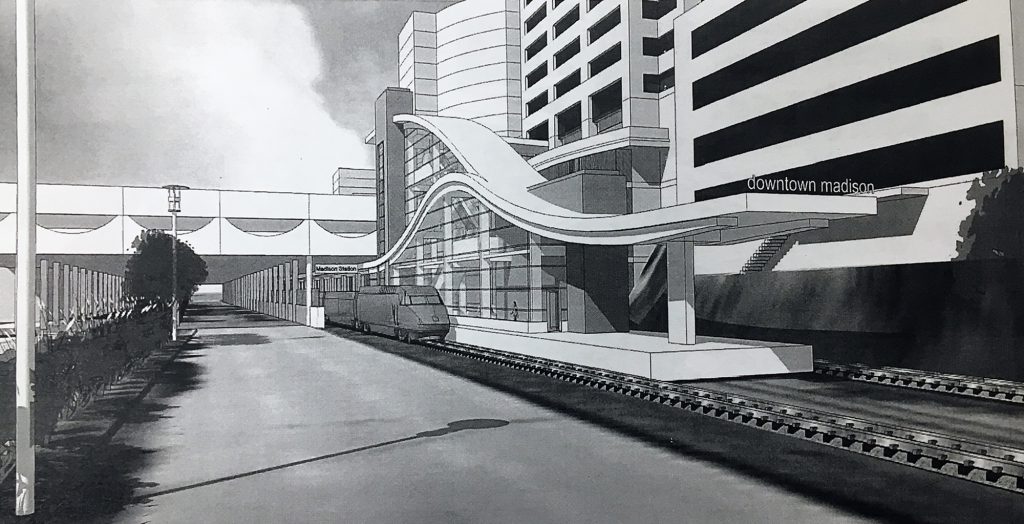
A mock-up of Madison’s proposed high-speed rail station on John Nolen Drive. Rendering courtesy of the Wisconsin Department of Transportation.
When thousands of conservatives gathered outside of the Wisconsin State Capitol on April 15, 2010, they felt like they were on the outside looking in.
Barack Obama had been president for a little more than a year, and Democrats controlled everything, from Congress to the governor’s office to the Wisconsin state Legislature.
Republicans were pushing back, and the Tea Party was in full swing.
There were rallies all over the country on this day. In Madison, people brought homemade protest signs and waved yellow “Don’t Tread on Me” flags.
Former Republican Gov. Tommy Thompson, the father of the high-speed rail plan, was there that day. Thompson was thinking about running for U.S. Senate. Word was he was going to announce his plans during his speech.
As he spoke, the crowd chanted “Run, Tommy, run!” Thompson paused, gathered himself and delivered the news.
Thompson wouldn’t run for office in 2010. Instead, that day he passed the baton.
He told people there were candidates in the crowd who needed their support. One of them was Milwaukee County Executive Scott Walker, who was running for governor.
Walker took questions from reporters that day about Thompson, other candidates and the Tea Party movement as a whole. He was also asked about the $810 million train state government was building with help from the federal government.
“My preference is to fight for that money to have it spent on roads and bridges and not on rail,” Walker said.
And if the federal government took the money back? Wisconsin would be better off, Walker said.
At this moment, Walker’s comment was just a subtle aside, but as the year went on, it would become a signature issue in his campaign.
Something was changing in American politics and in Wisconsin, and Walker used this train to seize the moment.
‘A Talk Radio Candidate’
To understand Walker, you have to understand how he went from a young state representative to Milwaukee County Executive and eventually to the governor’s office.
There were people along the way who helped him — some of them, quite a bit. Like longtime conservative talk radio host Charlie Sykes.
“I actually knew Scott before he was even a state representative,” Sykes said in an interview with WPR. “And then got to know him very well when he was in the state Legislature and he was sort of a backbencher. But he was a backbencher who understood how to use the media.”
Sykes hosted a morning call-in show on WTMJ-AM Radio in Milwaukee for 23 years, and Walker became a regular guest.
“There was no question about it that he was very much a talk radio candidate,” Sykes. “And yes, I certainly promoted his campaign.”
In 2010, there was little doubt who Sykes wanted as the next governor. Outgoing Gov. Jim Doyle was not seeking a third term, and Milwaukee Mayor Tom Barrett was running for Democrats.
The conservative base, which had watched Democrats win big in the last two elections, was getting fired up — and the proposed high-speed train stoked that fire.
Walker declined multiple requests to be interviewed for WPR’s “Derailed.” His top campaign advisors from 2010, Keith Gilkes and R.J. Johnson, also declined interviews.
But what Walker said about the train a decade ago is thoroughly documented, and Sykes remembers it well.
The Conservative Case Against Rail
The conservative case against the high-speed train had a few tenets, starting with one that undercut the very name of the project.
This train, conservatives argued, was not technically high-speed. The plan was for it to hit 110 mph by 2016, but at first, it would max out at 79 mph.
Sykes used a play on words to illustrate this for his listeners.
“Because I have an inner 12-year-old child inside of me, I refer to it as the ‘half-fast’ train,” Sykes said.
Sykes and Walker also hammered home the size of the rail grant.
“Eight-hundred-ten million dollars is a big enough number that it really captures people’s imagination,” Sykes said.
In the past, it would have been unheard of for Democrats or Republicans to turn down so much federal money. But for Sykes and Walker, it didn’t matter. This was government money. Taxpayer money.
Of course, that money would buy something: A new rail link, up to 5,500 construction jobs and 55 permanent jobs to operate the train.
But it would also cost something: The state of Wisconsin would eventually be on the hook for about $7.5 million every year to keep these trains running.
Walker said that was too expensive.
“Free money is not free,” Walker said at a press conference in March of 2010. “The reality is it comes with a cost.”
Walker had another bone to pick too. Madison and Milwaukee would benefit, he told people, but other communities would be shut out.
But there was something else going on here.
In 2010, Democrats ran everything and they had used their power to pass major policy. Obama was the face of the Democratic Party. And high-speed rail was his initiative.
U.S. Transportation Secretary Ray LaHood, who was a Republican U.S. representative from Peoria before joining the Obama administration, said the president’s involvement is what really bothered Republicans.
“I can think of no other reason why they would turn back that kind of money,” LaHood said.
At the national level, other Republican candidates started to copy Walker. In Ohio, John Kasich vowed during his campaign for governor that he’d also send back federal rail funds.
As Walker’s campaign for governor ramped up, he drove home the Obama connection. Walker put out an anti-train ad that featured video of him spliced together with President Obama.
“Change isn’t easy,” said a clip of Obama.
“But stopping runaway government spending is,” answered Walker.
Walker also registered a website called notrain.com featuring an open letter to Obama that called Wisconsin’s project a “boondoggle.”
‘There’s No Stopping It’
At the state level, Doyle was no longer running for governor, but he was still pushing hard to make this train happen.
And despite Walker’s repeated vows to stop it, the project was moving along. Many people assumed Walker’s comments were being made in the heat of the campaign, and would be forgotten if he won.
Doyle was asked during the summer of 2010 whether Walker even had the power to stop the train.
“I mean I guess short of sitting down in front of the federal government and defying the federal government, I don’t think it’s realistic to say … that this project would stop,” Doyle told reporters.
It was around this time that LaHood visited Watertown, about halfway between Milwaukee and Madison. Watertown was slated to have a stop on the rail line.
LaHood knew about Walker’s opposition to the train and wanted to beat it back. “High-speed rail is coming to Wisconsin,” LaHood said at this stop. “There’s no stopping it.”
Looking back, LaHood said he knew what Walker was saying about the train, and he “wanted to send a message that this is what the people wanted.”
But when some people heard LaHood’s comment, they thought it sounded heavy-handed, like the federal government was telling them what to do.
Watertown Mayor Ron Krueger was there that day.
“I was standing up next to him on the podium,” Krueger said. “And I thought, he didn’t just say that.”
Krueger, a lifelong Republican, supported the train project because he thought it would be good for his town. Watertown had picked out a spot for the train station and even moved a local grocery store across the street to make room.
Krueger’s friends and neighbors liked that the train could be good for Watertown’s economy, but were uneasy about all the government money and the connection to Obama.
So Krueger was not surprised when he heard about LaHood’s comment on conservative talk radio the next day.
“Friday morning, it was on WTMJ out of Milwaukee already,” Krueger said.
Andy Jorgensen was a nearby Democratic state legislator at the time who was pushing for the train — which would have come right through his district. He said Sykes was dictating the terms of the debate.
“He relentlessly, day after day, would talk about this,” Jorgensen said. “He would throw out all of this rhetoric that did stick to the wall that people would repeat over and over again.”
‘Trying To Put Him In A Corner’
In Madison, Mayor Dave Cieslewicz, a Democrat, had been holding out hope that Walker’s opponent Barrett might turn the election around and win.
Cieslewicz had big ideas for this train. He imagined passengers would get off the train at a new public market, where there would be restaurants, a hotel and maybe even a streetcar line.
But Barrett had trailed Walker in nearly every poll taken, and there were no signs in late 2010 that he was going to gain any ground.
“Doyle actually called me the Monday before the election,” Cieslewicz said. “And he said ‘Look, I’ve seen the latest polling data, it looks like Tom’s not going to make it. I’m gonna be out of office. You’re gonna have to kind of be the guy pushing for this.'”
According to Cieslewicz, the plan was to get as much in the ground as possible — to tie Walker’s hands before he even took office.
“To be perfectly blunt, we were trying to put him in a corner,” Cieslewicz said.
On Nov. 2, 2010, Walker defeated Barrett in the race for governor. And for a short time, despite Walker’s victory, it looked like the Doyle administration, with the help of Cieslewicz, would push forward with the train anyway.
But two days after the election, Doyle backed off, pausing work on the train. Looking back, Doyle said he had no choice.
“There’s just no way you could move forward on this size a project without the state and the federal government working together,” Doyle said. “The federal government can’t come into Wisconsin and build a rail system that the state wants no part of.”
The Final Stop
For train supporters, there was one last hope. Transportation Secretary LaHood, the longtime Republican, spoke with Walker after he was elected. LaHood said he tried to change Walker’s mind.
“I told him he was in a position that many other states would want to be in,” LaHood said. “He was well positioned to receive this money and implement a project for the people.”
LaHood says Walker suggested spending the $810 million on Wisconsin’s roads and bridges instead — the same idea he’d floated during his campaign.
But Walker wouldn’t budge.
“The moment that the high-speed rail project was dead was when Walker decided he didn’t want the money, and he told me that,” LaHood said.
LaHood would remember this.
Early the next year, when Walker was governor, his administration asked LaHood’s DOT for $150 million to upgrade the aging trains on the Hiawatha line between Milwaukee and Chicago.
Wisconsin got none of it.
Asked by WPR whether Walker’s position on the high-speed rail money between Madison and Milwaukee had anything to do with his decision, LaHood said “absolutely.”
“It had everything to do with my decision,” LaHood said. “The fact that he turned down millions of dollars for a rail project and then comes right back with something else … our feeling was that he was not going to be a reliable partner the way that other governors were.”
‘I Have Not Changed My Mind’
A lot has happened in the world of Sykes and Walker since that landmark election in 2010.
Walker is no longer governor, and Obama is no longer president. Republicans are no longer on the outside looking in.
In the 2016 election, Walker was slow to embrace Donald Trump, but eventually endorsed him and campaigned for him.
Sykes chose a much different path. He tried to stop Trump in 2016, and these days he’s a prominent “Never Trump” Republican on cable TV news. He even wrote a book called “How the Right Lost Its Mind.”
Sykes, who has since left the airwaves at WTMJ-AM, has changed his mind on a lot of things. But the train?
“No,” Sykes said. “I have not changed my mind on that one … I have many, many, many regrets. Many things that I would do differently. This is not one of them.”
To this day, Sykes calls the project a “boondoggle.”
“It was a bright, shiny object that people fell in love with,” Sykes said. “But ultimately failed the test of common sense.”
Listen to the third episode of the podcast here.
As Political Winds Change, Walker Uses Train To Seize The Moment was originally published by Wisconsin Public Radio.
This story is part of WPR’s “Derailed,” a limited-run podcast about Wisconsin’s high-speed rail line that never was. It’s a look at how the project came together, how it fell apart, and what it says about how Wisconsin has changed. Never miss an episode by subscribing now on your favorite podcast app or at wpr.org/derailed.
Derailed
-
Talgo Trains Return to Milwaukee
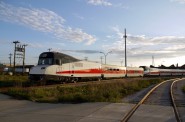 Dec 10th, 2019 by Bridgit Bowden and Shawn Johnson
Dec 10th, 2019 by Bridgit Bowden and Shawn Johnson
-
Could Doyle Have Saved High Speed Rail?
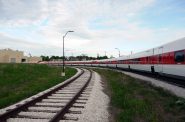 Nov 29th, 2019 by Bridgit Bowden and Shawn Johnson
Nov 29th, 2019 by Bridgit Bowden and Shawn Johnson
-
How Republicans Became Anti-Train
 Nov 15th, 2019 by Bridgit Bowden and Shawn Johnson
Nov 15th, 2019 by Bridgit Bowden and Shawn Johnson
Transportation
-
MPS Makes the Case for Referendum
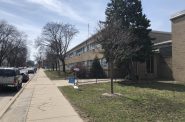 Mar 23rd, 2024 by Graham Kilmer
Mar 23rd, 2024 by Graham Kilmer
-
‘Fix at Six’ Group Wants I-94 Expansion Delayed For Civil Rights Report
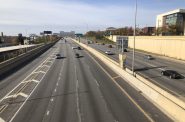 Mar 20th, 2024 by Jeramey Jannene
Mar 20th, 2024 by Jeramey Jannene
-
Wisconsin Has $78 Million Federal Funds For EV Charging Stations
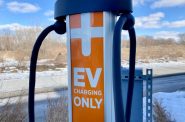 Mar 20th, 2024 by Erik Gunn
Mar 20th, 2024 by Erik Gunn


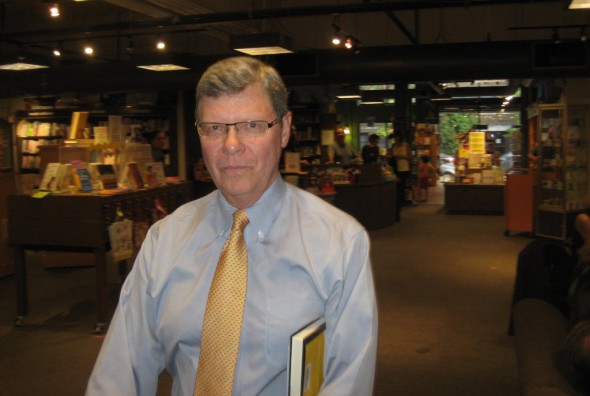
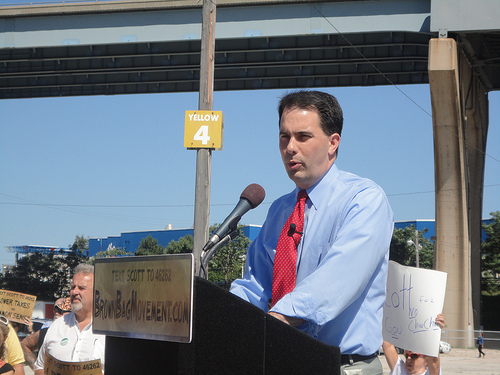















Now that he is a recovering reactionary (after his lucrative career as a recovering liberal) is it about time for Sykes to apologize to the citizens of WI for his roles in assisting reactionaries in their efforts to deprive the city of Milwaukee of light rail and the state of a fast train from Milwaukee to Madison and beyond?